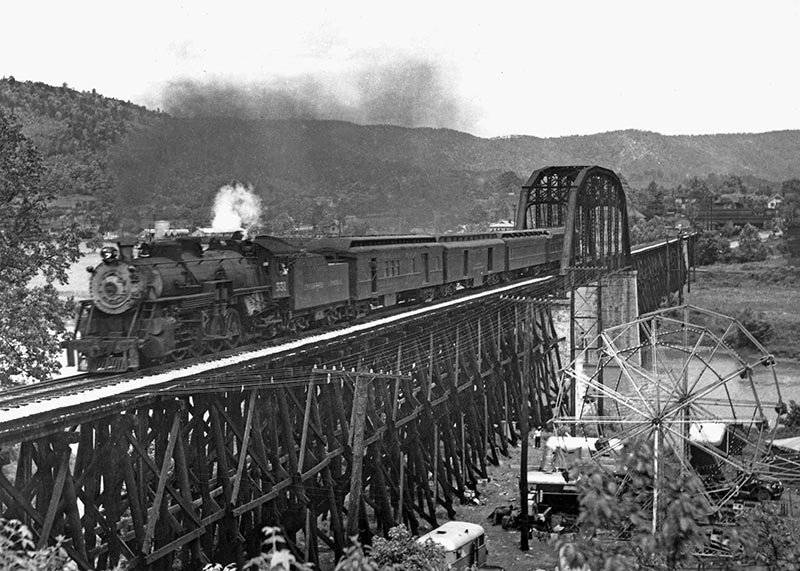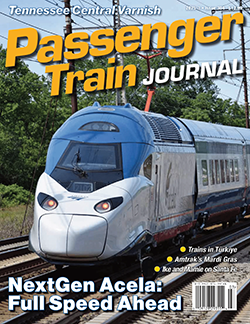 by Ralcon Wagner/photos as noted
by Ralcon Wagner/photos as noted
Tennessee Central spanned 295 miles from Harriman, Tenn., on the east to Hopkinsville, Ky., on the west, with branches to Carthage, Wilder, Isoline, and, after the early 1920s, Old Hickory. During the railroad’s early days, TC operated passenger service over most of its system, except for the latter branch. The company’s general offices, shops, and main yard were in the state capital, Nashville, a city close to the center of the railway. Looking at a map, one might conclude that TC passenger and freight trains ran directly between the western and eastern terminals, but in fact, Nashville was itself considered a terminal, with all trains originating or terminating there. Regularly scheduled passenger service never ran through the capital city.
TC was made up of two distinct parts, the Eastern and Western divisions. While both divisions were served by passenger trains during the first three decades after TC’s completion, the level of service was quite different for trains running west from Nashville compared to the service running east. Traditionally, trains on the Eastern Division had heavier ridership, therefore there were more trains operating between Nashville and Harriman compared with those going to Hopkinsville.
TC’s Early Years
Tennessee Central traced its earliest roots to Nashville & Knoxville Railroad, an east-west line chartered in 1884 by Alexander Crawford. N&K eventually stretched approximately 76 miles from Monterey to Lebanon, Tenn. At Lebanon, its western terminus and connection with Nashville, Chattanooga & St. Louis Railway, N&K passengers could transfer to travel the remaining 32 miles west to Nashville. For several years, Crawford struggled to expand his road eastward where it could connect with other railroads at Harriman or other points.
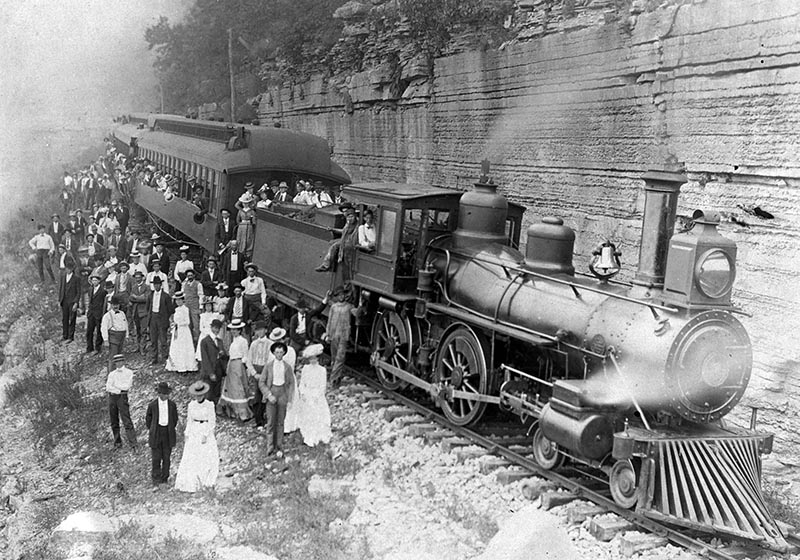
ABOVE: An excursion train from Nashville to Monterey, Tenn., has stopped near Lancaster so passengers and crew can pose for a portrait in this circa 1905 view. Much of TC’s passenger revenue came from operating special charter and excursion trains, a practice that continued beyond the discontinuance of regularly scheduled passenger service in 1955. —Louisville & Nashville Railroad Company Records, University Archives and Records Center, University of Louisville
Around this time, Col. Jeremiah “Jere” Baxter entered the picture. Baxter was an entrepreneur and successful businessman. One of his dreams was to build a railroad connecting Nashville and Knoxville. He purchased N&K after Crawford died unexpectedly, and built east from Monterey to Harriman. Baxter also attempted to buy the NC&StL branch from Lebanon to Nashville, but officials with the “NC” weren’t interested so Baxter built his own track to Nashville paralleling the rival railroad. Baxter’s track reached Nashville, with the first train arriving in May 1902. TC continued to forge northwest from Nashville, arriving at Clarksville in late 1903 and reaching its intended destination of Hopkinsville, Ky., in 1904.
Immediately after its arrival in Nashville, TC launched regular passenger service over its Eastern Division to Harriman in 1902 and initiated service to Hopkinsville two years later. At Hopkinsville, TC passengers could transfer to and from Illinois Central trains.
Named Trains and Lesser Lights
Regular passenger service had been established on TC by 1904, and the depot in downtown Nashville was the company’s busiest by far with seven daily arrivals and departures — five on the Eastern Division and two on the Western. Strangely, during the first several years of operation, many of the passenger trains traveling east had names, but trains destined for Hopkinsville never did.
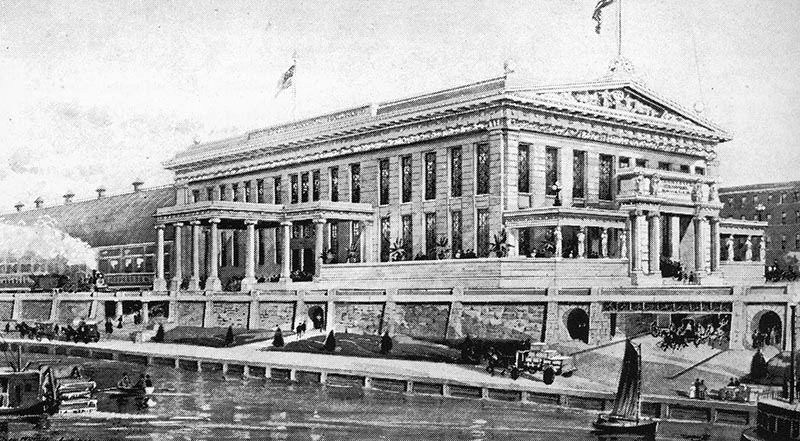
ABOVE: In October 1923, TC officials announced plans for a grand, new Nashville passenger terminal, to be located at the foot of Broadway on the west bank of the Cumber-land River. The first floor would serve as the passenger station, with upper floors housing TC’s general offices. Sadly, a lack of funding prevented the proposal from be-coming a reality, and TC’s “temporary” wooden station remained in use until passenger service ceased in 1955. —Charles B. Castner Collection
Heading east from Nashville, passengers had a good selection of trains to choose from between 1902 and 1910. Trains 1 and 2 were initially named the Knoxville Day Express and Nashville Day Express. As their names imply, they were daytime trains. They traveled as far as Harriman, where passengers were required to transfer to Southern Railway trains. In spite of the name “express,” these trains stopped at all 58 intermediate stations, although many were considered flag stops. Overnight service on this route was provided by trains 3 and 4, the Volunteer State Limited, to Harriman.
What made trains 3 and 4 unique was their through Pullman sleeper service between Nashville and Knoxville. At Harriman, the sleeper was handed over to one of Southern’s trains for the remainder of the trip. Service was initiated on December 25, 1904, and continued until the discontinuance of trains 3 and 4 in early 1949. Another noteworthy TC service was trains 7 and 8, accommodation runs that operated between Carthage Junction and Nashville. Originally nicknamed the “Shopping Train,” the westbound trip departed Carthage Junction at 6:30am and arrived in Nashville at 9:00am. The eastbound train departed Nashville at 4:00PM and arrived back at “the junction” at 6:36pm. This train was operated for the convenience of shoppers who wanted to spend the day in Nashville. As with the day trains mentioned previously, this train also stopped at all stations.
The fourth schedule that operated on the Eastern Division was trains 5 and 6, the Lebanon Local between Nashville and Lebanon. This was the shortest passenger run operating east from Nashville, at 32 miles. On TC’s Western Division, two name-less round-trips were operated between Nashville and Hopkinsville from 1903 until around 1915. Patronage on this line was not as promising as the eastern route, even though Clarksville was the second-largest city on TC after Nashville.
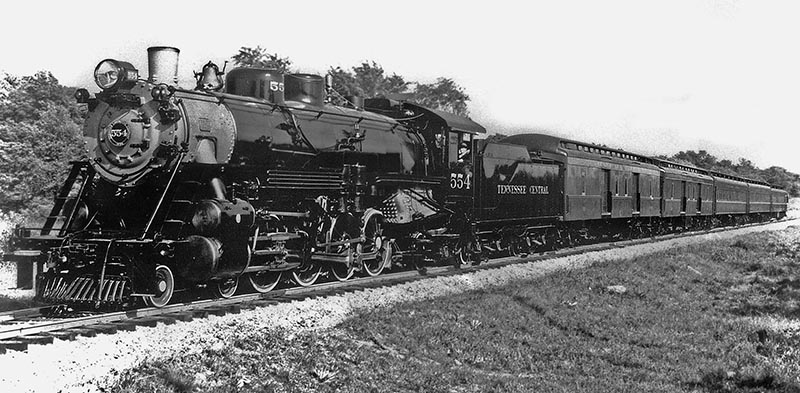
ABOVE: During the height of the passenger-train era, it was common for railroads to have publicity photos made of their newest equipment. This retouched portrait shows pristine American Locomotive Company 4-8-2 Mountain-type engine 554 in a classic “rods down” pose with a five-car TC train in 1926. —Author’s Collection
Because of TC’s continued financial hardship, service was soon cut on both divisions. After a few years, all names were dropped from trains on the Eastern Division. By the early 1920s, both the Lebanon Local and the popular Shopping Train had been discontinued, and one of the round-trips to Hopkinsville and been taken off as well. In November 1930, trains 11 and 14 were discontinued between Nashville and Hopkinsville, leaving the Western Division freight-only. A few years later, the impressive passenger station at Clarksville was sold and demolished.
In addition to its main line trains, during its early days TC also operated passenger trains on its Carthage, Crawford, and Isoline branches. Initially, some regular passenger service was provided on these branches, but this was replaced by mixed trains. By the early 1930s, all mixed trains had been discontinued.
Passenger Stations and Facilities
Tennessee Central’s passenger stations were usually built to a simple design, consisting of a board-and-batten wood-frame structure. Only a handful of stations were built with brick. These included Clarksville, Cookeville, Crossville, and Watertown — the latter two being replacements for buildings destroyed by fire.
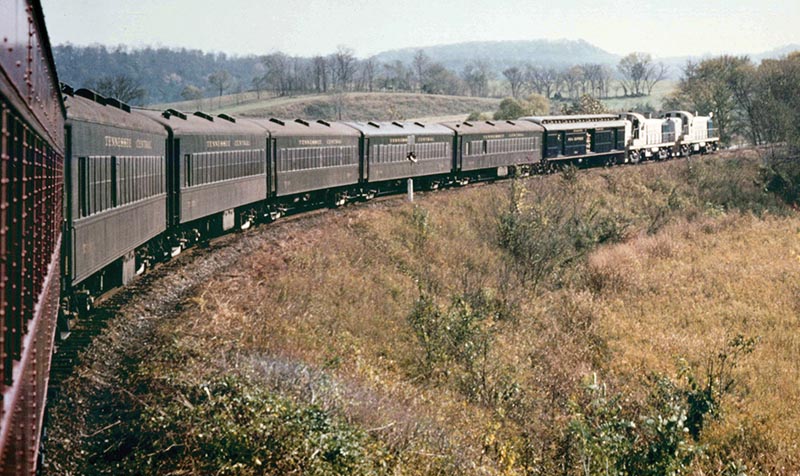
ABOVE: During 1967, TC ran several public excursions over the Eastern Division for public-relations purposes. The day trips operated to towns such as Monterey or Emory Gap, mostly using leased coaches. The trains, limited to 375 passengers, usually sold out quickly. This view from spring 1967 shows a seven-car train near the community of Cherry Valley, Tenn., on its return trip to Nashville. With two RS-3 units on the point, recently repainted in an attractive blue-and-gray TC color scheme, the train included a three-door baggage car from Louisville & Nashville, five commuter cars leased from Reading, and TC observation car 102. This trip was part of the last excursion season operated by the railroad. In just over a year, on August 31, 1968, Tennessee Central ceased to exist. —G. Battle Claiborne
Surprisingly, perhaps, the most impressive of TC’s stations was in Clarksville. When the railroad arrived in 1903, it purchased the 1880-era Tobacco Exchange Building on the west side of the public square and extensively remodeled it, routing its track past the building. The majestic structure served passengers and railroad employees for 27 years until passenger service ceased in 1930. It was demolished a few years later.
In Nashville, on the other hand, TC employed a passenger facility that was modest at best. It consisted of a wooden L-shaped structure, with three stub-end tracks served by two platforms with umbrella-type train sheds. In later years the building deteriorated, and the sheds were removed in the mid-1940s. After passenger service ceased in 1955, the station remained open as additional space for other railroad departments. It was razed in 1963…


